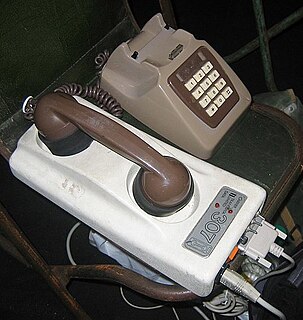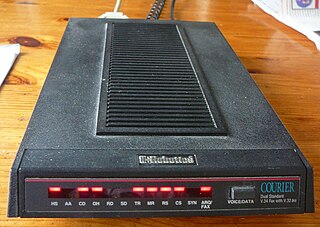Fall back is a feature of a modem protocol in data communication whereby two communicating modems which experience data corruption (due to line noise, for example) can renegotiate with each other to use a lower-speed connection. Fall forward is a corresponding feature whereby two modems which have "fallen back" to a lower speed can later return to the higher speed if the connection improves.
In telecommunication, a communication protocol is a system of rules that allow two or more entities of a communications system to transmit information via any kind of variation of a physical quantity. The protocol defines the rules, syntax, semantics and synchronization of communication and possible error recovery methods. Protocols may be implemented by hardware, software, or a combination of both.

A modem is a hardware device that converts data between transmission media so that it can be transmitted from computer to computer. The goal is to produce a signal that can be transmitted easily and decoded to reproduce the original digital data. Modems can be used with any means of transmitting analog signals from light-emitting diodes to radio. A common type of modem is one that turns the digital data of a computer into modulated electrical signal for transmission over telephone lines and demodulated by another modem at the receiver side to recover the digital data.

Data corruption refers to errors in computer data that occur during writing, reading, storage, transmission, or processing, which introduce unintended changes to the original data. Computer, transmission, and storage systems use a number of measures to provide end-to-end data integrity, or lack of errors.
A common feature modems was the concept of fallback, allowing them to talk to less-capable modems. During the call initiation the modem would play a series of signals into the line and wait for the remote modem to "answer" them. They would start at high speeds and progressively get slower and slower until they heard an answer. Thus, two USR modems would be able to connect at 9600 bit/s, but, when a user with a 2400-bit/s modem called in, the USR would "fall back" to the common 2400-bit/s speed. This would also happen if a V.32 modem and a HST modem were connected. Because they used a different standard at 9600 bit/s, they would fall back to their highest commonly supported standard at 2400 bit/s. The same applies to V.32bis and 14400 bit/s HST modem, which would still be able to communicate with each other at only 2400 bit/s.
A modem that can fall back in order to communicate with an older, slower modem is an example of backward compatibility, while one that can fall back in order to communicate when the line becomes noisy is an example of graceful degradation.

Backward compatibility is a property of a system, product, or technology that allows for interoperability with an older legacy system, or with input designed for such a system, especially in telecommunications and computing. Backward compatibility is sometimes also called downward compatibility.
In telecommunications, RS-232, Recommended Standard 232 refers to a standard originally introduced in 1960 for serial communication transmission of data. It formally defines signals connecting between a DTE such as a computer terminal, and a DCE, such as a modem. The standard defines the electrical characteristics and timing of signals, the meaning of signals, and the physical size and pinout of connectors. The current version of the standard is TIA-232-F Interface Between Data Terminal Equipment and Data Circuit-Terminating Equipment Employing Serial Binary Data Interchange, issued in 1997. The RS-232 standard had been commonly used in computer serial ports.

Dial-up Internet access is a form of Internet access that uses the facilities of the public switched telephone network (PSTN) to establish a connection to an Internet service provider (ISP) by dialing a telephone number on a conventional telephone line. The user's computer or router uses an attached modem to encode and decode information into and from audio frequency signals, respectively.
Automatic baud rate detection refers to the process by which a receiving device determines the speed, code level, start bit, and stop bits of incoming data by examining the first character, usually a preselected sign-on character (syncword) on a UART connection. ABR allows the receiving device to accept data from a variety of transmitting devices operating at different speeds without needing to establish data rates in advance.

In computing, a serial port is a serial communication interface through which information transfers in or out one bit at a time. Throughout most of the history of personal computers, data was transferred through serial ports to devices such as modems, terminals, and various peripherals.
The Hayes command set is a specific command language originally developed by Dennis Hayes for the Hayes Smartmodem 300 baud modem in 1981.
U.S. Robotics Corporation, often called USR, is a company that produces USRobotics computer modems and related products. Its initial marketing was aimed at bulletin board systems, where its high-speed HST protocol made FidoNet transfers much faster, and thus less costly. During the 1990s it became a major consumer brand with its Sportster line. The company had a reputation for high quality and support for the latest communications standards as they emerged, notably in its V.Everything line, released in 1996.
Telebit was a US-based modem manufacturer, known for their TrailBlazer series of high-speed modems. One of the first modems to routinely exceed 9600 bit/s speeds, the TrailBlazer used a proprietary modulation scheme that proved highly resilient to interference, earning the product an almost legendary reputation for reliability despite mediocre line quality. They were particularly common in Unix installations in the 1980s and 1990s.

Null modem is a communication method to directly connect two DTEs using an RS-232 serial cable. The name stems from the historical use of RS-232 cables to connect two teleprinter devices or two modems in order to communicate with one another; null modem communication refers to using a crossed-over RS-232 cable to connect the teleprinters directly to one another without the modems.
It is also used to serially connect a computer to a printer, since both are DTE, and is known as a Printer Cable.
Satellite Internet access is Internet access provided through communications satellites. Modern consumer grade satellite Internet service is typically provided to individual users through geostationary satellites that can offer relatively high data speeds, with newer satellites using Ku band to achieve downstream data speeds up to 506 Mbit/s.
Hayes Microcomputer Products was a U.S.-based manufacturer of modems. The company is well known for the Smartmodem, which introduced a control language for operating the functions of the modem via the serial interface, in contrast to manual operation with front-panel switches. This smart modem approach dramatically simplified and automated operation. Today almost all modems use a variant of the Hayes command set.

A digital subscriber line (DSL) modem is a device used to connect a computer or router to a telephone line which provides the digital subscriber line service for connectivity to the Internet, which is often called DSL broadband.

The Apple USB Modem is a combined 56 kbit/s data modem and 14.4 kbit/s fax external USB modem introduced by Apple Inc. after the internal 56k modem was dropped on the October 12, 2005 iMac G5 revision. While it looks similar, it should not be confused with Apple's optional USB Ethernet Adapter accessory, available for its MacBook Air and MacBook Pro Retina range of laptops since 2008.
Protocol spoofing is used in data communications to improve performance in situations where an existing protocol is inadequate, for example due to long delays or high error rates.
Lynx is a protocol for the transfer of files over modems. The protocol uses a flow control batch data transmission protocol designed to achieve efficient, reliable, and flexibile file transfers. It was developed by Matthew Thomas, who released it in 1989.
Microcom Networking Protocol (MNP) family of error-correcting protocols were commonly used on early high-speed modems. Originally developed for use on Microcom's own family of modems, the protocol was later openly licensed and used by most of the modem industry, notably the "big three", Telebit, USRobotics and Hayes. MNP was later supplanted by v.42bis, which was used almost universally starting with the first v.32bis modems in the early 1990s.
Microcom, Inc. was a major modem vendor during the 1980s, although never as popular as the "big three", Hayes, U.S. Robotics (USR) and Telebit. Nevertheless, Microcom holds an important place in modem history for introducing the MNP error-correction and compression protocols, which were widely used under license by most modem manufacturers in the 1990s.
The company went public in 1987. Compaq purchased publicly outstanding shares of the company in 1997.
Fbus is an ANSI/IEEE data bus protocol oriented towards backplanes and cell phones. The standard specifies a way for various pieces of electronic hardware to communicate, typically with one piece acting as master, and another acting as a slave. The F-Bus is a bi-directional full-duplex serial type bus running at 115,200 bit/s, 8 data bits, no parity, one stop bit (8N1). Much like a standard RS-232 serial port, F-Bus connections use one pin for data transmit, one pin for data receive and one pin for ground.

Asymmetric digital subscriber line (ADSL) is a type of digital subscriber line (DSL) technology, a data communications technology that enables faster data transmission over copper telephone lines than a conventional voiceband modem can provide. ADSL differs from the less common symmetric digital subscriber line (SDSL). In ADSL, bandwidth and bit rate are said to be asymmetric, meaning greater toward the customer premises (downstream) than the reverse (upstream). Providers usually market ADSL as a service for consumers for Internet access for primarily downloading content from the Internet, but not serving content accessed by others.
The CompuCom SpeedModem was an early high speed modem that implemented a proprietary 9600 bit/s protocol known as the CompuCom Speed Protocol (CSP). Their modems were much less expensive than competing high-speed models, and were well known for a time. The introduction of standards-based v.32bis modems made the SpeedModem disappear with surprising speed.








